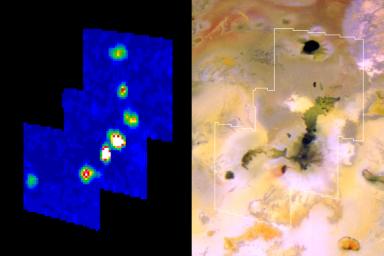
|
Amirani Lava Flow on Io
- Click the image above for a larger view
- Full-Res JPEG (720 x 480) (35.0 kB)
- Full-Res TIFF (720 x 480) (606.9 kB)
Caption:
The Amirani lava flow on Jupiter's moon Io appears to be made up of many individual flows; the newest flows are the brightest spots in this infrared image from NASA's Galileo spacecraft.
The thermal map from Galileo's near-infrared mapping spectrometer instrument is presented on the left, beside a reference picture of the same area from Galileo's camera. The infrared image uses false color to indicate intensity of glowing at a wavelength of 5 microns. White, reds and yellows indicate hotter regions; blues are cold. North is to the top.
Amirani is the largest active lava flow known in the solar system. Galileo has previously observed many changes in its flows . In this infrared image, Amirani includes the two brightest spots and two others closest to that pair. The image also shows three other active volcanoes on Io: Maui (lower left, corresponding to a dark, roughly circular area in the reference image), Dusurra (top, corresponding to the dark, roughly circular area at the top of the reference image) and an unnamed hot spot that appears as an elongated small feature in the reference image between Dussura and the Amirani flow.
Of Amirani's four bright areas, the one on the lower left corresponds to what is thought to be the flow's vent: a dark elongated crater surrounded by red materials. Red deposits are indicative of recent plume activity on Io. The other three bright areas along the flow correspond to where hot lavas are breaking out.
Notice that the dark flow going from the main flow to the left is not seen in the infrared image. This indicates that this flow has cooled and is no longer active. NASA's Voyager spacecraft detected a plume more than 20 years ago from a location near the end of this now-inactive flow. The plume was probably created by interaction of the hot flow with sulfur-dioxide frost, in the same way as Io's Prometheus plume . Once the flow cooled, the plume shut off.
This infrared image was taken on Aug. 6, 2001. It has a resolution of about 9 kilometers (6 miles) per picture element.
Background Info:
The Jet Propulsion Laboratory, a division of the California Institute of Technology in Pasadena, manages the Galileo mission for NASA's Office of Space Science, Washington, D.C. Additional information about Galileo and its discoveries is available on the Galileo mission home page at http://solarsystem.nasa.gov/galileo/ .
Cataloging Keywords:
| Name | Value | Additional Values |
|---|---|---|
| Target | Io | |
| System | Jupiter | |
| Target Type | Satellite | |
| Mission | Galileo | Voyager |
| Instrument Host | Galileo Orbiter | |
| Host Type | Orbiter | Flyby Spacecraft |
| Instrument | Near-Infrared Mapping Spectrometer (NIMS) | |
| Detector | ||
| Extra Keywords | Color, Crater, Infrared, Map, Plume, Thermal, Volcano | |
| Acquisition Date | ||
| Release Date | 2002-05-28 | |
| Date in Caption | 2001-08-06 | |
| Image Credit | NASA/JPL/University of Arizona | |
| Source | photojournal.jpl.nasa.gov/catalog/PIA03533 | |
| Identifier | PIA03533 | |
